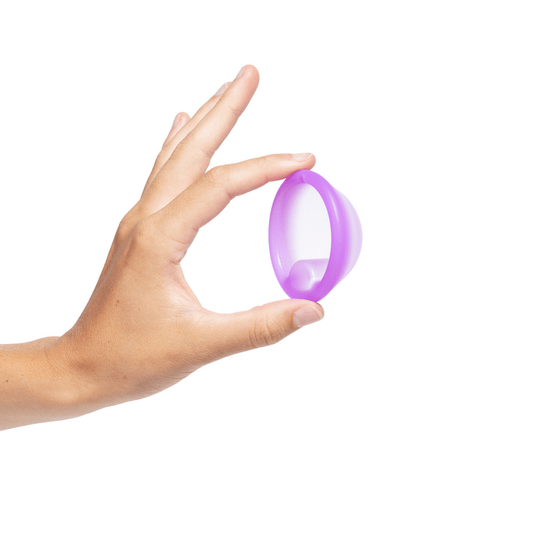
How to Insert a Tampon: Step-by-Step Guide
Share
Are you having trouble inserting a tampon? Do you feel like you're doing something wrong? You're definitely not alone. In fact, many women have trouble inserting a tampon the first time they try. It can be tricky, but don't worry, we're here to help!
In this step-by-step guide, we will teach you how to insert a tampon like a pro. So read on and learn everything you need to know about tampon insertion!
How to insert a tampon: Step-by-Step
- Make sure you wash your hands before insertion.
- Unwrap the tampon and get it ready to put into the vagina. The tampon wrapper is meant to be discarded. (If your tampon has a compact applicator, like the Garnuu Organic Tampons, pull the bottom part where the string comes out just slightly until you hear a clicking sound. That means the tampon applicator is ready to be inserted.)
- Sit on a toilet with your knees apart OR if you stand, put one foot higher on a toilet seat.
- Place your thumb and middle finger in the middle of the applicator where ridges and tube end. Then place your index finger at the bottom of the applicator where the string comes out.
- Make sure you already have your period before inserting the tampon. You’ll want some moisture for easy insertion and removal.
- Slowly insert the top half of the applicator into the vaginal opening. Make sure the tampon is angled toward your back. Keep inserting until your thumb and middle finger hit the base of your vagina.
- Use your index finger to push the thinner part of the applicator. You will feel the tampon move a few more inches inside of you. You should stop where the thick and thin ends of the applicator meet.
- The tampon inside your vagina should be 100% in the vaginal opening. Only the tampon string should be out.
You’re done! That's how to insert a tampon! If you’ve put it in correctly you shouldn’t feel any pain when you stand up or walk around. If you do feel pain, then more than likely the tampon isn’t far enough in.
Take it out and try to put a NEW tampon in.

Tampon Removal
- Sit on the toilet
- Spread your knees and grab a hold of the string.
- If you can’t find the string, move your fingers around until you do. When we go to the bathroom or move around a lot, the string may also move. If you need help finding the string, grab a mirror.
- Once you have a hold of the string, slowly and gently pull it out. You can either put the tampon in the toilet if there are no signs or you can wrap it toilet paper and place it into the wastebasket next to the toilet. All septic systems are different, and if you are unsure that the septic system can handle flushed sanitary products, discard the tampon in the trash.
If your vaginal walls are lubricated with menstrual blood, it will be painless. However, if you feel pain or friction, it’s probably because the tampon is too dry! Meaning: you should switch to a lower absorbency next time or wait longer before you take it out.
How you know the tampon is inserted wrong
When a tampon is inserted correctly, there should be no pain, irritation, and the tampon should be unnoticeable in the vagina. If any of these things are happening, it means that the tampon is inserted incorrectly and needs to be fixed.
There are a few different ways to know that your tampon has been inserted wrong:
-You feel pain when inserting or removing the tampon.
-The string is not hanging outside of the vagina after insertion.
-You feel discomfort or irritation during wear.
-The tampon feels like it's stuck inside of you.
If any of these things are happening, don't worry! Just calmly remove the tampon and try again.
When should a tampon be removed?
A tampon should be left in the vagina for no more than eight hours to prevent leaks and Toxic Shock Syndrome. We recommend changing your tampon every four to six hours, or more frequently if you have a heavy flow.
How will I know when the tampon is full?
You’ll be able to feel when the tampon is full because it will start to feel uncomfortable or like it’s falling out. This usually happens before the eight-hour mark.
Toxic Shock Syndrome
Toxic Shock Syndrome (TSS) is a rare, life-threatening complication of certain bacterial infections. It most commonly occurs in teenage girls and young women who are menstruating and using tampons. When a tampon is used for longer than eight hours, this can occur.
TSS occurs when bacteria from your vagina enters your bloodstream and releases poisonous toxins. TSS is NOT contagious, which means it cannot be spread from person to person.
The symptoms of TSS include a sudden high fever (usually 102 degrees Fahrenheit or higher), vomiting or diarrhea, fainting or near fainting when standing up, a rash that looks like a sunburn, with redness all over the body, muscle aches and confusion.
Remove the tampon and seek medical attention immediately if this occurs.
Once you get the hang of tampon insertion, it will be a breeze! Just remember to relax, take your time and use the right absorbency for your flow. And don't forget to change your tampon every four to six hours, or more frequently if you have a heavy flow.
If you have any questions or concerns about tampon use, please consult your healthcare provider.
Thanks for reading, Garnuu Girl!
XOXO, Garnuu Team








